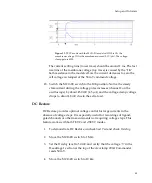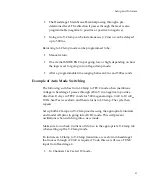
User
Guide
for
Axoclamp
900A
Interfacing
a
Computer
Because
the
Axoclamp
900A
is
a
computer
‐
controlled
instrument,
the
installation
of
a
computer
in
your
electrophysiology
rig
is
obligatory.
The
minimum
computer
configuration
requires
a
USB
port
for
communicating
with
the
Axoclamp
900A.
However,
in
order
to
make
full
use
of
the
power
and
convenience
of
your
computer,
it
is
recommended
that
you
also
attach
a
digitizing
interface,
such
as
the
Digidata
1440.
An
interface
allows
you
to
generate
command
signals
and
save
the
data
in
a
very
flexible
manner,
without
the
cost
and
complexity
of
a
conventional
system
based
on
stimulators,
digital
oscilloscopes,
laboratory
tape
recorders
and
chart
recorders.
Digitizing
interfaces
are
typically
connected
to
the
computer
via
a
card
(
i.e.,
a
USB
card)
that
is
provided
with
the
interface.
Finally,
it
is
necessary
to
install
software
to
control
the
interface.
Software
is
available
from
Molecular
Devices
(pCLAMP)
or
other
vendors,
or
you
can
write
your
own.
To
be
able
to
telegraph
to
the
Axoclamp
900A
you
need
to
use
pCLAMP
10.
The
beauty
of
the
Axoclamp
package
is
that
you
are
not
tied
to
any
particular
PC
data
acquisition
software.
Any
PC
‐
based
software
that
is
able
to
control
the
digitizing
interface
is
acceptable,
while
the
Axoclamp
900A
Commander
runs
in
the
background
controlling
the
Axoclamp
900A.
Noise
Measurement
of
Noise
Noise
is
reported
in
two
different
ways
in
this
manual.
Peak
‐
to
‐
peak
(
p
‐
p
)
noise.
This
measure
finds
favor
because
it
is
easily
estimated
from
an
oscilloscope
and
its
meaning
is
intuitively
obvious.
A
disadvantage
is
that
it
is
very
insensitive
to
structure
in
the
noise
(
e.g.,
different
frequency
components).
For
this
reason,
it
is
most
commonly
used
for
quantifying
“white”
noise
(see
Filters
in
this
chapter).
62
















































